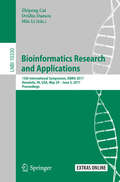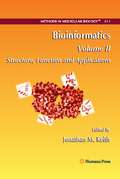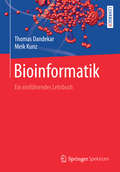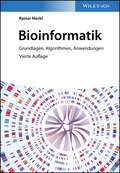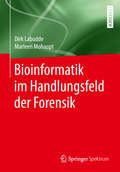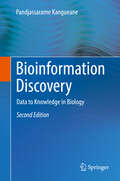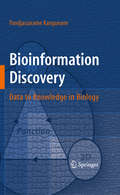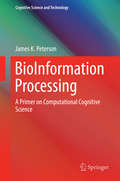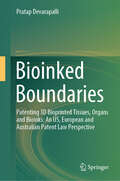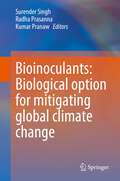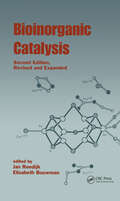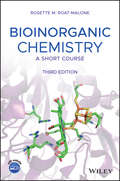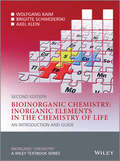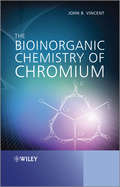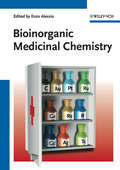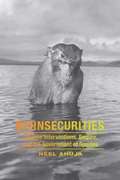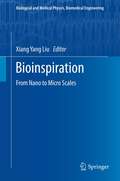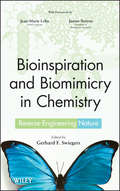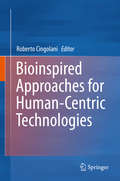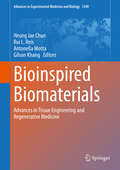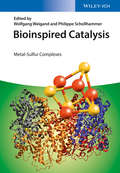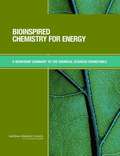- Table View
- List View
Bioinformatics Research and Applications: 13th International Symposium, ISBRA 2017, Honolulu, HI, USA, May 29 – June 2, 2017, Proceedings (Lecture Notes in Computer Science #10330)
by Zhipeng Cai, Ovidiu Daescu and Min LiThis book constitutes the proceedings of the 13th International Symposium on Bioinformatics Research and Applications, ISBRA 2017, held in Honolulu, HI, USA, in May/June 2017. The 27 full papers presented together with 18 short papers and 24 invited abstracts were carefully reviewed and selected from 131 submissions. They cover topics such as: biomarker discovery; biomedical databases and data integration; biomedical text mining and ortologies; biomolecular imaging; comparative genomics; computational genetic epidemiology; computational proteomics; data mining and visualization; gene expression analysis; genome analysis; high-performance bio-computing; metagenomics; molecular evolution; molecular modelling and simulation; next-generation sequencing data analysis; pattern discovery and classification; population genetics; software tools and applications; structural biology; and systems biology.
Bioinformatics Techniques for Drug Discovery: Applications For Complex Diseases (SpringerBriefs in Computer Science)
by Aman Chandra Kaushik Ajay Kumar Shiv Bharadwaj Ravi Chaudhary Shakti SahiThe application of bioinformatics approaches in drug design involves an interdisciplinary array of sophisticated techniques and software tools to elucidate hidden or complex biological data. This work reviews the latest bioinformatics approaches used for drug discovery. The text covers ligand-based and structure-based approaches for computer-aided drug design, 3D pharmacophore modeling, molecular dynamics simulation, the thermodynamics of ligand−receptor and ligand−enzyme association, thermodynamic characterization and optimization, and techniques for computational genomics and proteomics.
Bioinformatics, Volume II: Volume II: Structure, Function and Applications (Methods in Molecular Biology #453)
by Jonathan M. KeithNot only is the quantity of life science data expanding, but new types of biological data continue to be introduced as a result of technological development and a growing understanding of biological systems. Methods for analyzing these data are an increasingly important component of modern biological research. In Bioinformatics, leading researchers in the field provide a selection of the most useful and widely applicable methods, able to be applied as is, or with minor variations, to many specific problems. Volume II: Structure, Function and Applications contains methods pertinent to the prediction of protein and RNA structures and the analysis and classification of structures, methods for inferring the function of previously identified genomic elements, chiefly protein-coding genes, medical applications in diagnostics and drug discovery, and "meta-methods" for developers of bioinformatics algorithms. As a volume of the highly successful Methods in Molecular Biology™ series, this work provides the kind of detailed description and implementation advice that is crucial for getting optimal results.<P><P> Comprehensive and cutting-edge, Bioinformatics: Volume II: Structure, Function and Applications is an ideal reference for all scientists involved with the ever-growing array of data in the expanding field of life science.
Bioinformatik: Ein einführendes Lehrbuch
by Thomas Dandekar Meik KunzDieses Buch bietet eine packende Einf#65533;hrung in das am schnellsten wachsende Gebiet der Biologie mit leicht nachvollziehbaren Beispielen und einem gut aufbereitetem Anhang f#65533;r den Leser, der so gleich alles direkt nachkochen und miterleben kann. Das Buch holt den Leser bei den Grundlagen ab, wie man zum Beispiel Sequenzinformationen einfach erh#65533;lt und analysiert. In weiteren Kapiteln gehen die Autoren auf die verschiedenen Analysem#65533;glichkeiten von RNA, DNA und Proteinen bis hinzu ganzen Stoffwechselwegen ein. Dabei werden in jedem Kapitel spannende Beispiele aus der Biologie gew#65533;hlt, die zur Veranschaulichung der Analyse dienen. Jedes Kapitel wird mit einem #65533;bungsteil abgeschlossen, welches das Gelernte sogleich zur Anwendung bringt. Das Thema dieses Buches ist ein Muss f#65533;r jeden Biologiestudierenden, ob Bachelor- oder Masterstudium, da die Bioinformatik mittlerweile erstaunliche Einsichten in die molekularen Grundlagen aller Lebewesen zutage f#65533;rdert.
Bioinformatik: Ein einführendes Lehrbuch
by Thomas Dandekar Meik KunzDieses Buch bietet eine packende Einführung in das am schnellsten wachsende Gebiet der Biologie mit leicht nachvollziehbaren Beispielen und einem gut aufbereiteten Anhang für die Leserschaft, um so gleich alles direkt nachkochen und miterleben zu können.Das Buch holt den Leser und die Leserin bei den Grundlagen ab, wie man zum Beispiel Sequenzinformationen einfach findet und dann analysiert. In weiteren Kapiteln gehen die Autoren auf die verschiedenen Analysemöglichkeiten von RNA, DNA und Proteinen bis hin zu ganzen Stoffwechselwegen ein. Dabei werden in jedem Kapitel spannende Beispiele aus der Biologie gewählt, die zur Veranschaulichung der Analyse dienen. Jedes Kapitel wird mit einem Übungsteil abgeschlossen, welches das Gelernte sogleich zur Anwendung bringt.Das Thema dieses Buches ist ein Muss für jeden Biologiestudierenden, ob Bachelor- oder Masterstudium, da die Bioinformatik mittlerweile erstaunliche Einsichten in die molekularen Grundlagen aller Lebewesen zutage fördert. Informatikstudierende und andere Studierende aus angrenzenden Naturwissenschaften bekommen einen guten Einstieg in die Bioinformatik, denn neben der Software werden systematisch die Biologie und aktuelle Themen (z.B. KI) Schritt für Schritt eingeführt.Entdecken Sie gemeinsam mit den Autoren den Schlüssel zum Leben und lernen Sie die Sprache des Lebens verstehen.
Bioinformatik: Grundlagen, Algorithmen, Anwendungen
by Rainer MerklBioinformatik Der Marktführer bei den Bioinformatiklehrbüchern in neuer Auflage und mit dem neuen Thema Molekulardynamik Bioinformatik ist eine Kerndisziplin in den modernen Biowssenschaften, von der Biotechnologie über die Biochemie und Molekularbiologie bis zur Molekulargenetik und Molekularmedizin. Sie ist eine essenzielle Grundlage für alle “omics”-Technologien, für die Strukturbiologie, die Systembiologie sowie die synthetische Biologie. Bioinformatik. Grundlagen, Algorithmen, Anwendungen bietet eine umfassende Einführung in die wichtigsten Methoden der Bioinformatik. Der Autor erklärt dabei sowohl die mathematischen und biologischen Grundlagen als auch die wichtigsten Software-Tools und deren Anwendungsbereiche. Schwerpunkte sind Methoden zum Sequenzvergleich, Verfahren zur Charakterisierung von Proteinfamilien, Algorithmen zur Vorhersage von Protein- und RNA-Strukturen, Methoden des maschinellen Lernens und das Proteindesign. Für die 4. Auflage wurde der Text durchgehend aktualisiert und um ein Kapitel zur Molekulardynamik erweitert. Neu aufgenommene Exkurse zu Meilensteinen der Bioinformatik und aktuellen Anwendungsgebieten lockern den Text auf. Auf der ebenfalls komplett überarbeiteten Begleit-Webseite werden interaktive Lernmodule bereitgestellt, einschließlich mehr als 120 Übungsaufgaben, zum Teil mit Lösungen. Eine perfekte Einführung für alle Studenten der Lebenswissenschaften oder Informatik, die einen Einblick in die gängigen Methoden der Bioinformatik benötigen, sowie ein wertvoller Begleiter für alle, die bereits bioinformatische Werkzeuge nutzen und die zugrundeliegenden Konzepte verstehen möchten.
Bioinformatik am Beispiel des SARS-CoV2 Virus und der Covid19 Pandemie (essentials)
by Thomas Dandekar Meik KunzIn diesem Buch werden dem Leser einführend zentrale Ansätze der Bioinformatik entsprechend dem Fluss der genetischen Information von der Sequenzanalyse vom Virusgenom und seinen Proteinen über die Strukturvorhersage hin zu komplexeren Analysen (Interaktionen mit dem Wirt, Immunsystem) vorgestellt. Proteinnetzwerke, Metabolismus und Signalkaskaden erlauben dem Virus, eine hochgefährliche Infektion im Menschen zu erzeugen. Die Bioinformatik leistet wertvolle Hilfestellung bei der Diagnose, der Suche nach Behandlungsmöglichkeiten und vor allem bei der Herstellung von Impfstoffen und dem Vorhersehen des Pandemieverlaufs.Der InhaltBioinformatik ist einfach und schnell anzuwendenErste Detailanalysen (Sequenzen, Proteine, Gene)Analyse von Protein-NetzwerkenBioinformatik in der Infektionsbiologie und medizinische ImplikationenBioinformatik und Covid19 – ein globales PhänomenAnhang: Nützliche Webressourcen und LiteraturstellenDie ZielgruppenStudenten der Biologie und Medizin, die einen ersten Einblick in die Bioinformatik haben möchtenAllgemeines Publikum
Bioinformatik im Handlungsfeld der Forensik
by Dirk Labudde Marleen MohauptDieses Lehrbuch soll Studierenden den Einstieg in die Gebiete der Forensik und Bioinformatik gleichermaßen erleichtern. Anhand eines fiktiven Falls, der sich durch das gesamte Buch zieht, wird die Bioinformatik und deren Grundlagen in das Gebiet der Forensik übertragen. Der Fall deckt eine Vielzahl an biologischen Spuren, sowie deren klassische Analyse ab und definiert neue Handlungsfelder in der Bioinformatik und Forensik.In diesem Werk werden verschiedenste Bereiche der Forensik bioinformatisch aufbereitet: Genetischer Fingerabdruck: Auswertung auf Sequenz- statt auf Profilebene Fingerspuren: krankheitsbedingte bzw. genetisch bedingte VeränderungenUntersuchungen zum Phänotyp einer PersonGrundlegende Erkenntnisse zur Wundheilung sowie zur Blutalterung in- und ex-vivo Dieses Buch zeigt die Notwendigkeit auf, die Forensik um weitere Wissensbereiche zu ergänzen und gibt Einblicke in eine Vielzahl moderner Themen der Forensik wie zum Beispiel Populationsgenetik; Wundaltersbestimmung, Daktyloskopie oder Menschen ohne Fingerabdruck.Vor allem Studierende aus den Lebenswissenschaften sowie Dozierende ebendieser Fachrichtung, werden durch dieses Lehrbuch spannende Einblicke in topaktuelle Fragestellungen bekommen.
Bioinformation Discovery: Data to Knowledge in Biology
by Pandjassarame KangueaneThis new edition continues to illustrate the power of biological data in knowledge discovery. It describes biological data types and representations with examples for creating a workflow in bioinformation discovery. The concepts in knowledge discovery from data are illustrated using line diagrams. The principles and concepts in knowledge discovery are used for the development of prediction models for simulations of biological reactions and events. Advanced topics in molecular evolution and cellular & molecular biology are addressed using bioinformation gleaned through discovery. Each chapter contains approximately 10 exercises for practice. This will help students to expand their problem solving skills in Bioinformation Discovery. In this new edition, there are three new chapters covering single nucleotide polymorphism, genes, proteins and disease, and protein functions driven by surface electrostatics.
Bioinformation Discovery: Data to Knowledge in Biology
by Pandjassarame KangueaneBioinformation Discovery illustrates the power of biological data in knowledge discovery. It describes biological data types and representations with examples for creating a workflow in Bioinformation discovery. The concepts in knowledge discovery from data are illustrated using line diagrams. The principles and concepts in knowledge discovery are used for the development of prediction models for simulations of biological reactions and events. Advanced topics in molecular evolution and cellular & molecular biology are addressed using Bioinformation gleaned through discovery. Each chapter contains approximately 10 exercises for practice. This will help students to expand their problem solving skills in Bioinformation Discovery. Each chapter concludes with a number of good problem sets to test mastery of the material.
BioInformation Processing: A Primer on Computational Cognitive Science (Cognitive Science and Technology)
by James K. PetersonThis book shows how mathematics, computer science and science can be usefully and seamlessly intertwined. It begins with a general model of cognitive processes in a network of computational nodes, such as neurons, using a variety of tools from mathematics, computational science and neurobiology. It then moves on to solve the diffusion model from a low-level random walk point of view. It also demonstrates how this idea can be used in a new approach to solving the cable equation, in order to better understand the neural computation approximations. It introduces specialized data for emotional content, which allows a brain model to be built using MatLab tools, and also highlights a simple model of cognitive dysfunction.
Bioinked Boundaries: Patenting 3D Bioprinted Tissues, Organs and Bioinks: An US, European and Australian Patent Law Perspective
by Pratap DevarapalliThis book presents a comprehensive and comparative study of the patentability of bioprinting inventions, specifically bioinks and bioprinted tissues, in the US, the Europe and Australia. It employs a two-phase analysis to understand, ‘Is the patentable subject matter requirement a hurdle to patenting bioprinting inventions, specifically bioinks and bioprinted tissues?’ The first phase is a doctrinal analysis of the patent laws and jurisprudence in respective jurisdictions, highlighting the similarities and differences in their approaches to the subject matter requirement. The second phase is an empirical analysis of the patent prosecution data from patent applications filed in each jurisdiction with claims directed towards bioprinted tissues and bioinks, revealing how patent examiners apply the patent provisions to accept or object to such patent claims. The book offers several contributions to the field of bioprinting and patent law. First, it provides a detailed and up-to-date overview of the current state of the art and the legal landscape of bioprinting inventions. Second, it identifies the main criteria and factors that patent examiners use to assess the patentable subject matter of bioprinted tissues and bioinks, such as the level of human intervention, the markedly different characteristics, and the industrial applicability. Third, it proposes patenting framework models for each jurisdiction, which can assist patent applicants to draft and amend their patent claims in accordance with the patentable subject matter requirement. Fourth, it evaluates the potential benefits and implications of patenting bioprinting inventions for the bioprinting industry and society at large, such as fostering innovation, promoting public health, and indirectly addressing ethical and social issues. The main benefit that the reader will derive from the book is a deeper understanding of the patentability of bioprinting inventions, specifically bioinks and bioprinted tissues, in different jurisdictions and contexts. The book will help the reader to appreciate the legal and technical aspects of bioprinting and patent law, and how they affect the bioprinting industry and society at large.
Bioinoculants: Biological Option for Mitigating global Climate Change
by Surender Singh Radha Prasanna Kumar PranawThis edited book covers various bioinoculants for sustainable crop production under the changing global climate. The book envisages a compilation of articles relevant to the current status of production and use of novel microbial inoculants for different crops and highlights their role in mitigating global climate challenges. These include nutrient deficiencies, salinity, drought, and emerging pathogens. In addition, success stories and commercialization aspects are also discussed. Growing environmental concerns related to climate change can potentially decrease the global yield capacity of agricultural systems. Agricultural productivity is severely affected by major biotic and abiotic factors. The phytomicrobiome plays a critical role in the survival of the holobiont, particularly for plants growing in extreme environments. The use of microbial-based agricultural inputs has a long history, beginning with a broad-scale rhizobial inoculation of legumes in the early twentieth century. Microbial inoculants are considered one of the best and most effective strategies for sustainable agriculture under climate change, and a viable solution to meet the twin challenges of global food security and environmental sustainability. It is therefore imperative to understand the current status and development in the area of bioinoculants from a global perspective. The chapter’s focus would be on major agro-ecologies, covering all major crops across the globe, along with the commercialization status of different bioinoculants in different countries The book caters to the needs of the students, faculty, policymakers, and researchers working in the area of microbiology, biotechnology, environmental sciences, and botany.
Bioinorganic Catalysis
by Jan Reedijk Elisabeth Bouwman"Provides the latest research results and suggests new topics for interdisciplinary study of metal ions, catalysis, and biochemical systems. Second Edition highlights potential applications; includes new chapters on zinc and FeS clusters; presents new X-ray analysis of metalloenzymes; and more."
Bioinorganic Chemistry: A Short Course
by Rosette M. Roat-MaloneIntroduces students to the basics of bioinorganic chemistry This book provides the fundamentals for inorganic chemistry and biochemistry relevant to understanding bioinorganic topics. It provides essential background material, followed by detailed information on selected topics, to give readers the background, tools, and skills they need to research and study bioinorganic topics of interest to them. To reflect current practices and needs, instrumental methods and techniques are referred to and mixed in throughout the book. Bioinorganic Chemistry: A Short Course, Third Edition begins with a chapter on Inorganic Chemistry and Biochemistry Essentials. It then continues with chapters on: Computer Hardware, Software, and Computational Chemistry Methods; Important Metal Centers in Proteins; Myoglobins, Hemoglobins, Superoxide Dismutases, Nitrogenases, Hydrogenases, Carbonic Anhydrases, and Nitrogen Cycle Enzymes. The book concludes with chapters on Nanobioinorganic Chemistry and Metals in Medicine. Readers are also offered end-of-section summaries, conclusions, and thought problems. Reduces size of the text from previous edition to match the first, keeping it appropriate for a one-semester course Offers primers and background materials to help students feel comfortable with research-level bioinorganic chemistry Emphasizes select and diverse topics using extensive references from current scientific literature, with more emphasis on molecular biology in the biochemistry section, leading to a discussion of CRISPR technology Adds new chapters on hydrogenases, carbonic anhydrases, and nitrogen cycle enzymes, along with a separate chapter on nanobioinorganic chemistry Features expanded coverage of computer hardware and software, metalloenzymes, and metals in medicines Supplemented with a companion website for students and instructors featuring Powerpoint and JPEG figures and tables, arranged by chapter Appropriate for one-semester bioinorganic chemistry courses, Bioinorganic Chemistry: A Short Course, Third Edition is ideal for upper-level undergraduate and beginning graduate students. It is also a valuable reference for practitioners and researchers in need of a general introduction to the subject, as well as chemists requiring an accessible reference.
Bioinorganic Chemistry -- Inorganic Elements in the Chemistry of Life
by Brigitte Schwederski Axel Klein Wolfgang KaimThe field of Bioinorganic Chemistry has grown significantly in recent years; now one of the major sub-disciplines of Inorganic Chemistry, it has also pervaded other areas of the life sciences due to its highly interdisciplinary nature.Bioinorganic Chemistry: Inorganic Elements in the Chemistry of Life, Second Edition provides a detailed introduction to the role of inorganic elements in biology, taking a systematic element-by-element approach to the topic. The second edition of this classic text has been fully revised and updated to include new structure information, emerging developments in the field, and an increased focus on medical applications of inorganic compounds. New topics have been added including materials aspects of bioinorganic chemistry, elemental cycles, bioorganometallic chemistry, medical imaging and therapeutic advances.Topics covered include:Metals at the center of photosynthesisUptake, transport, and storage of essential elementsCatalysis through hemoproteinsBiological functions of molybdenum, tungsten, vanadium and chromiumFunction and transport of alkaline and alkaline earth metal cationsBiomineralizationBiological functions of the non-metallic inorganic elementsBioinorganic chemistry of toxic metalsBiochemical behavior of radionuclides and medical imaging using inorganic compoundsChemotherapy involving non-essential elements This full color text provides a concise and comprehensive review of bioinorganic chemistry for advanced students of chemistry, biochemistry, biology, medicine and environmental science.
The Bioinorganic Chemistry of Chromium
by John VincentChromium exists in nature as complexes of two stable oxidation states - trivalent chromium(III) and hexavalent chromium(VI). Although trivalent chromium is required in trace amounts for sugar and lipid metabolism in humans and its deficiency may cause a disease called chromium deficiency; hexavalent chromium is toxic and carcinogenic. As chromium compounds were used in dyes and paints and the tanning of leather, these compounds are often found in soil and groundwater at abandoned industrial sites, now needing environmental cleanup and remediation.The Bioinorganic Chemistry of Chromium: From Biochemistry to Environmental Toxicology takes a critical look at what the biochemical data indicate about chromium's role in the body and the biological mechanisms of its toxicology. Topics covered include:What do we know about the biochemical roles and mechanisms of chromium?Is chromium an essential element in the mammalian diet?Is chromium(III) effective as a nutraceutical, a therapeutic agent, and as a supplement in animal feed?What is the biochemistry behind the toxicology of chromium(III) and chromium(VI):the mechanisms of metabolism, genetic and epigenetic effects, and disruption of cell signalling?What are the current chromium(VI) policies and positions from regulatory agencies?The Bioinorganic Chemistry of Chromium: From Biochemistry to Environmental Toxicology is an important contribution to the bioinorganic and trace element biochemical fields which will find a place on the bookshelves of bioinorganic chemists, biochemists, inorganic chemists, toxicologists, nutritionists and regulatory affairs professionals.
Bioinorganic Medicinal Chemistry
by Enzo AlessioThis book gives a comprehensive overview about medicinal inorganic chemistry. Topics like targeting strategies, mechanism of action, Pt-based antitumor drugs, radiopharmaceuticals are covered in detail and offer the reader an in-depth overview about this important topic.
Bioinsecurities: Disease Interventions, Empire, and the Government of Species
by Neel AhujaIn Bioinsecurities Neel Ahuja argues that U.S. imperial expansion has been shaped by the attempts of health and military officials to control the interactions of humans, animals, viruses, and bacteria at the borders of U.S. influence, a phenomenon called the government of species. The book explores efforts to control the spread of Hansen's disease, venereal disease, polio, smallpox, and HIV through interventions linking the continental United States to Hawai'i, Panamá, Puerto Rico, Cuba, Congo, Iraq, and India in the twentieth and twenty-first centuries. Ahuja argues that racial fears of contagion helped to produce public optimism concerning state uses of pharmaceuticals, medical experimentation, military intervention, and incarceration to regulate the immune capacities of the body. In the process, the security state made the biological structures of human and animal populations into sites of struggle in the politics of empire, unleashing new patient activisms and forms of resistance to medical and military authority across the increasingly global sphere of U.S. influence.
Bioinspiration: From Nano to Micro Scales (Biological and Medical Physics, Biomedical Engineering)
by Xiang Yang LiuMethods in bioinspiration and biomimicking have been around for a long time. However, due to current advances in modern physical, biological sciences, and technologies, our understanding of the methods have evolved to a new level. This is due not only to the identification of mysterious and fascinating phenomena but also to the understandings of the correlation between the structural factors and the performance based on the latest theoretical, modeling, and experimental technologies. Bioinspiration: From Nano to Micro Scale provides readers with a broad view of the frontiers of research in the area of bioinspiration from the nano to macroscopic scales, particularly in the areas of biomineralization, antifreeze protein, and antifreeze effect. It also covers such methods as the lotus effect and superhydrophobicity, structural colors in animal kingdom and beyond, as well as behavior in ion channels. A number of international experts in related fields have contributed to this book, which offers a comprehensive and synergistic look into challenging issues such as theoretical modeling, advanced surface probing, and fabrication. The book also provides a link to the engineering of novel advanced materials playing an important role in advancing technologies in various fields.
Bioinspiration and Biomimicry in Chemistry
by Janine Benyus Jean-Marie Lehn Gerhard SwiegersCan we emulate nature's technology in chemistry?Through billions of years of evolution, Nature has generated some remarkable systems and substances that have made life on earth what it is today. Increasingly, scientists are seeking to mimic Nature's systems and processes in the lab in order to harness the power of Nature for the benefit of society.Bioinspiration and Biomimicry in Chemistry explores the chemistry of Nature and how we can replicate what Nature does in abiological settings. Specifically, the book focuses on wholly artificial, man-made systems that employ or are inspired by principles of Nature, but which do not use materials of biological origin.Beginning with a general overview of the concept of bioinspiration and biomimicry in chemistry, the book tackles such topics as:Bioinspired molecular machinesBioinspired catalysisBiomimetic amphiphiles and vesiclesBiomimetic principles in macromolecular scienceBiomimetic cavities and bioinspired receptorsBiomimicry in organic synthesisWritten by a team of leading international experts, the contributed chapters collectively lay the groundwork for a new generation of environmentally friendly and sustainable materials, pharmaceuticals, and technologies. Readers will discover the latest advances in our ability to replicate natural systems and materials as well as the many impediments that remain, proving how much we still need to learn about how Nature works.Bioinspiration and Biomimicry in Chemistry is recommended for students and researchers in all realms of chemistry. Addressing how scientists are working to reverse engineer Nature in all areas of chemical research, the book is designed to stimulate new discussion and research in this exciting and promising field.
Bioinspired Approaches for Human-Centric Technologies
by Roberto CingolaniThe present book discusses topics related to research and development of materials and devices at nanoscale size and their respective application in medicine and biomedicine. The individual chapters give a detailed state of the art overview to the distinct topic. Apparently disconnected fields - life sciences, biomedicine, chemistry, physics, medicine and engineering - will be bridged with a highly interdisciplinary view onto each subject.
Bioinspired Biomaterials: Advances in Tissue Engineering and Regenerative Medicine (Advances in Experimental Medicine and Biology #1249)
by Rui L. Reis Heung Jae Chun Gilson Khang Antonella MottaThis book is the first of two volumes that together offer a comprehensive account of cutting-edge advances in the development of biomaterials for use within tissue engineering and regenerative medicine. Topics addressed in this volume, which is devoted to bioinspired biomaterials, range from novel biomaterials for regenerative medicine through to emerging enabling technologies with applications in, for example, drug delivery, maternal–fetal medicine, peripheral nerve repair and regeneration, and brain tumor therapy. New bioinspired hydrogels receive detailed attention in the book, and a further focus is the use of bioinspired biomaterials in the regulation of stem cell fate. Here the coverage includes the role of scaffolds in cartilage regeneration, the bioapplication of inorganic nanomaterials in tissue engineering, and guidance of cell migration to improve tissue regeneration. The authors are recognized experts in the interdisciplinary field of regenerative medicine and the book will be of value for all with an interest in regenerative medicine based on biomaterials.
Bioinspired Catalysis
by Wolfgang Weigand Philippe SchollhammerThe growing interest in green chemistry calls for new, efficient and cheap catalysts. Living organisms contain a wide range of remarkably powerful enzymes, which can be imitated by chemists in the search for new catalysts. In bioinspired catalysis, chemists use the basic principles of biological enzymes when creating new catalyst analogues. In this book, an international group of experts cover the topic from theoretical aspects to applications by including a wide variety of examples of different systems. This valuable overview of bioinspired metal-sulfur catalysis is a must-have for all scientists working in this hot field, including PhD students, postdocs and researchers.
Bioinspired Chemistry For Energy: A Workshop Summary To The Chemical Sciences Roundtable
by National Research Council of the National AcademiesFaced with the steady rise in energy costs, dwindling fossil fuel supplies, and the need to maintain a healthy environment - exploration of alternative energy sources is essential for meeting energy needs. Biological systems employ a variety of efficient ways to collect, store, use, and produce energy. By understanding the basic processes of biological models, scientists may be able to create systems that mimic biomolecules and produce energy in an efficient and cost effective manner. On May 14-15, 2007 a group of chemists, chemical engineers, and others from academia, government, and industry participated in a workshop sponsored by the Chemical Sciences Roundtable to explore how bioinspired chemistry can help solve some of the important energy issues the world faces today. The workshop featured presentations and discussions on the current energy challenges and how to address them, with emphasis on both the fundamental aspects and the robust implementation of bioinspired chemistry for energy.
